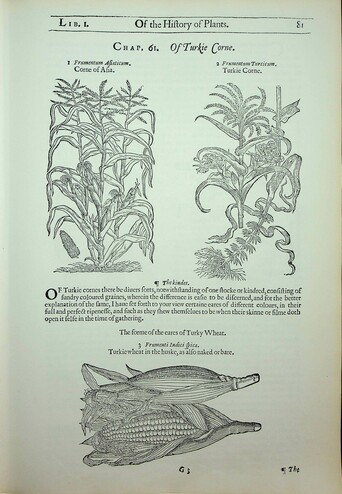Chap. 61. Of Turkie Corne
- Date
- 1636
- Material
- Book
- Author/Maker
- John Gerard
- Source
- Plimoth Patuxet Museums Collections

Description
English botanist John Gerald’s popular The Herball, or Generall Historie of Plantes (1597) featured woodcut illustrations accompanied by descriptions and notes on hundreds of plants known to Europeans in the 16th and 17th centuries. Herbals were common sources of information regarding cultivating, harvesting, and common household uses, including a plant’s medical properties, often referred to as its “natures and virtues.”1In his description of “turkie corne,” Gerard wrote:
these kinds of grain were first brought into Spain, and then into the other provinces of Europe: not (as some suppose) out of Asia minor, which is the Turks dominions; but out of America and the Islands adjoining, as out of Florida and Virginia or Norembega, where they use to sow or set it to make bread of it, where it grows much higher than in other countries. It is planted in the gardens of these Northern regions where it comes to ripeness when the summer falleth out to be faire and hot; as my self have seen by proof in mine own garden.2
Corn, or maize, is one of the world’s most important crops. Originating in South and Central America over six thousand years ago, corn is now grown around the world. Along with wheat and rice, it provides most of the energy in the human diet. Scientists believe that corn is descended from the Mexican grass teosite, but they do not know how ancient Indigenous farmers transformed the small teosite ear into the now familiar ear of corn. The oldest corn fossils feature cobs about one inch (2.54cm) long with roughly ten kernels.
There are several varieties of maize still in use today. Flint corn (Indian Corn) has hard kernels and can come in a variety of colors. This was the type of corn grown by the Wampanoag and the Pilgrims. Today it is grown to feed people and livestock and is often used as autumn decorations on doors and tables. Dent Corn is the most commonly used corn in North America, primarily used for processed foods, livestock feed and industrial products. Flour Corn is one of the oldest types of corn. Grown throughout South and Central America, it is starchy and easily pounded into flour. Sweet corn is soft, yellow or white corn that is popular for eating on the cob. Popcorn is one of the oldest types of corn and has been grown for thousands of years. It has an extremely hard kernel with a soft, moist starchy core that pops when heated. Waxy Corn gets its name from the waxy appearance of its hull and is most often used as a thickener for puddings, gravies, sauces, and glue.
Grain was an important part of both Wampanoag and colonial diets. 70% of the Wampanoag diet came from plants, including corn, beans, and squash. For the Wampanoag, “corn” meant flint corn. An English person’s daily diet centered on bread, grain-based soups and other calorie-dense foods that sustained them through an incredibly labor-intensive 17th-century working day. For the English, “corn” was a general term for “grain” and could be used to refer to wheat, peas, barley, rye, or oats. After arriving in New England, it became clear to the colonists that the English “corns” they had cultivated for generations would not grow as well as the native flint corn. Almost immediately, colonial housewives began to substitute flint corn for the English grains in their cooking and baking. In 1621, Mayflower passenger Edward Winslow advised a friend not to bring rice. He said: “our Indian corn even the coarsest,… maketh as pleasant meat as rice.”3 The Pilgrims planted some English grains, but it was flint corn (also known as Indian corn or maize) that grew the best in southeastern New England. A generation afterMayflower’s arrival, John Withrop Jr. commented in an essay for the Royal Society:
Nature hath delighted it selfe to beautify this Corne - with great Variety of colours, the White, and the Yellow being most common, being such as yellow as is between Straw Colour, and a pale yellow; there are also of very many other Colours, Red, Yellow, Blew, Olive Colour, and Greenish, and some very black and some of the Intermediate degrees of such Colours, also many sorts of mixt colours and speckled or striped.4
In 17th-century Plymouth and Patuxet, corn was one of the most important trade goods in Indigenous and colonial economic exchanges. Calling it “more precious than silver,”5 the colonists used corn amongst themselves as currency and as a valuable trade commodity. Starting in 1625, Plymouth’s leader began trading bushels of corn for beaver and other animal pelts with the Abenaki and other Indigenous communities along the Kennebeck River. A shorter growing season during what is now known as The Little Ice Age made it very difficult for the Abenaki and their northern neighbors to reliably grow corn. The profits from sales of fur to the English textile merchants - particularly for making into fashionable beaver felted hats - was essential to the colony’s long-term financial success.
In the early 1990s, Plimoth Patuxet Museums began working with Dr. Ann Kennedy (University of Massachusetts Amherst Agricultural Experimental Station) and renowned corn expert Walton C. Galient to recreate the 8-row flint commonly grown in 17th-century Patuxet and Plymouth in the 17th century. Inspired by surviving heirloom corn varieties, such as the Rhode Island flint corn, and descriptions from writers including John Winthrop Jr., the team created a new, genetically modified heirloom seed that matches historical descriptions. Now known as “Plimoth 8-Row Flint,” this corn is cultivated each year in the Museum’s living history exhibits.
Transcription
Of The History of Plants
CHAP. 61. Of Turkey Corn.
- Frumentum Afiaticum.
- Corne of Asia
- Frumentum Turcicum
Turkie Corne
The Kinds.
Of Turkey Corn there be divers sorts, notwithstanding of one stock or kindred, consisting of sundry coloured grains, wherein the difference is easy to be discerned, and for the better explanation of the same, I have set forth to your view certain ears of different colours, in their full and perfect ripeness, and such as they show themselves to be when their skin or film doth open itself in the time of gathering.
The forme of the eares of Turky Wheat.
- Frumenti Indici
Turkie wheat in the huske, as also naked or bare.
Media

Chap. 61. Of Turkie Corne
View PDFTranscription
Of The History of Plants
CHAP. 61. Of Turkey Corn.
- Frumentum Afiaticum.
- Corne of Asia
- Frumentum Turcicum
Turkie Corne
The Kinds.
Of Turkey Corn there be divers sorts, notwithstanding of one stock or kindred, consisting of sundry coloured grains, wherein the difference is easy to be discerned, and for the better explanation of the same, I have set forth to your view certain ears of different colours, in their full and perfect ripeness, and such as they show themselves to be when their skin or film doth open itself in the time of gathering.
The forme of the eares of Turky Wheat.
- Frumenti Indici
Turkie wheat in the huske, as also naked or bare.
Discussion Questions
- What names does Gerard use for corn? How many different names for corn can you find in this description?
-
How would you describe corn to someone who had never seen it before? Compare your description to Gerard’s? Do you agree with his description? Why or why not?
-
According to Gerard, where did people think corn came from? How does he correct them?
-
How would you describe corn to someone who had never seen it before?
-
In Gerald’s opinion, how does corn’s nutritional value compare to that of English grains such as wheat or rye? To the 17th-century reader, what impact could eating corn have on your body?
- Would an Indigenous culture keeper or a modern nutrition expert agree with Gerard’s assessment of corn? Why or why not? (You may need to do some additional research!)
- You may be familiar with modern agricultural feed corn (dent corn), popcorn, or corn on the cob (sweet corn). How do those types of corn differ from the ones Gerard is describing?
Footnotes
- 1 John Gerard, The Herball, or Generall Historie of Plantes, (London: Printed by Adam Islip Joice Norton and Richard Whitakers. 1636), pg.80
- 2 Gerard, The Herball, pg 82
- 3Mourt’s Relation: A Journey of the Pilgrims in Plymouth ed. By Dwight Heath (Bedford MA: Applewood Books) 82.
- 4 John Winthrop Jr. Report to the Royal Society, 1662.
- 5 William Bradford, Of Plimoth Plantation. (Boston: Conserved and digitized by the State Library of Massachusetts, 2014). pg. 115


